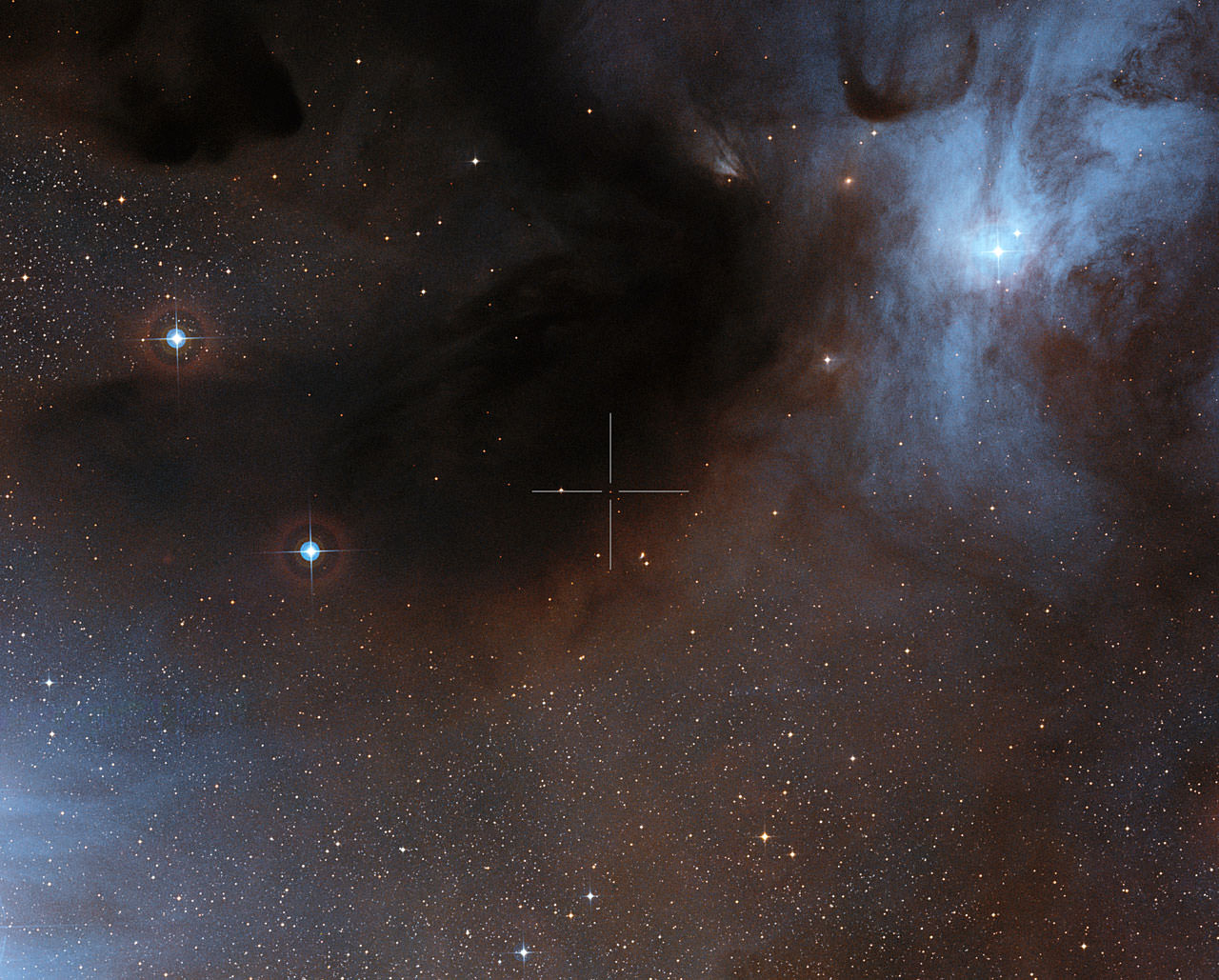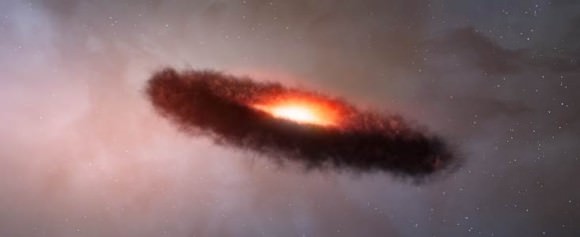This image shows the brown dwarf ISO-Oph 102, or Rho-Oph 102, in the Rho Ophiuchi star-forming region. Its position is marked by the crosshairs. This visible-light view was created from images forming part of the Digitized Sky Survey 2. Credit: ALMA (ESO/NAOJ/NRAO)/Digitized Sky Survey 2. Acknowledgement: Davide De Martin
Brown dwarfs inhabit a kind of fuzzy line between stars and planets: their mass is seemingly too small for them to be full-fledged stars and yet they are too large to be planets. These dim stars were only discovered in 1995 but current estimates say that brown dwarfs could be as numerous as normal stars in our galaxy. Now, astronomers have found a brown dwarf that has a dusty disc encircling it, just like the discs encircling regular, young stars. It contains millimeter-sized solid grains, and around other newborn stars, these discs of cosmic dust are where planets form. Astronomers say this surprising find challenges theories of how rocky, Earth-scale planets form, and suggests that rocky planets may be even more common in the Universe than expected.
Rocky planets are thought to form through the random collision and sticking together of what are initially microscopic particles in the disc of material around a star. These tiny grains are similar to very fine soot or sand. However, in the outer regions around a brown dwarf, astronomers expected that grains could not grow because the discs were too sparse, and particles would be moving too fast to stick together after colliding. Also, prevailing theories say that any grains that manage to form should move quickly towards the central brown dwarf, disappearing from the outer parts of the disc where they could be detected.
“We were completely surprised to find millimeter-sized grains in this thin little disc,” said Luca Ricci of the California Institute of Technology, USA, who led a team of astronomers based in the United States, Europe and Chile. “Solid grains of that size shouldn’t be able to form in the cold outer regions of a disc around a brown dwarf, but it appears that they do. We can’t be sure if a whole rocky planet could develop there, or already has, but we’re seeing the first steps, so we’re going to have to change our assumptions about conditions required for solids to grow,” he said.
Artist’s impression of the disc of dust and gas around a brown dwarf. Credit: ESO
Ricci and his team used the Atacama Large Millimeter/submillimeter Array (ALMA) for their observations. Even though the telescope is not completely finished yet, ALMA’s high resolution allowed the team to pinpoint carbon monoxide gas around the brown dwarf — the first time that cold molecular gas has been detected in such a disc. This discovery, along with the millimeter-size grains, suggest that the disc is much more similar to the ones around young stars than previously expected.
ALMA, located in the high-altitude Chilean desert is a collection of high precision, dish-shaped antennas that work together as one large telescope to observe the Universe in millimeter-wavelengths, enabling observations of extreme detail and sensitivity. Construction of ALMA is scheduled to finish in 2013, but astronomers began observing with a partial array of ALMA dishes in 2011.
The astronomers pointed ALMA at the young brown dwarf ISO-Oph 102, also known as Rho-Oph 102, in the Rho Ophiuchi star-forming region in the constellation of Ophiuchus. The brown dwarf has about 60 times the mass of Jupiter but only 0.06 times that of the Sun, and so has too little mass to ignite the thermonuclear reactions by which ordinary stars shine. However, it emits heat released by its slow gravitational contraction and shines dimly with a reddish color.
The astronomers were able to determine the grains in the disc are a millimeter or more in size.
“ALMA is a powerful new tool for solving mysteries of planetary system formation,” said Leonardo Testi from ESO, a member of the research team. “Trying this with previous generation telescopes would have needed almost a month of observing — impossibly long in practice. But, using just a quarter of ALMA’s final complement of antennas, we were able to do it in less than one hour!” he said.
When ALMA is completed, the team hopes to turn the telescope again towards Rho-Oph 102 and other similar objects.
“We will soon be able to not only detect the presence of small particles in discs,” said Ricci, “but to map how they are spread across the circumstellar disc and how they interact with the gas that we’ve also detected in the disc. This will help us better understand how planets come to be.”
Source: ESO



Would it be easier to find planets around a brown dwarf using Doppler shift, due to the low central mass, or harder, because low luminosity maybe makes it harder to get a spectrum?
i’d imagine low luminosity, long wavelength of emission and high ambient radiation all conspire to make that difficult. great question.
i bet there’s a lot of them in those clouds.
If considering that most bigger planets seem to have regular moons which comprise a kind of 2nd level planetary system, to me this result is not surprising. It rather seems, that condensation of planet-like object extends hierarchically down to this level.
To the artists picture in the article: shouldn’t a dust ring (disregarding the gaseous part) be much flatter more resembling planetary rings?
I have to agree. I pretty much assume that most any celestial object of sufficient size could have something orbiting it. If a gas cloud is large enough to rotate and collapse into an object many times the size of Jupiter why shouldn’t part of that cloud flatten out and form a planet? Stars form binary pairs and have planets, planets have moons, blackholes have whole galaxies of stars orbiting them. Why should brown dwarves be the exception?
If you consider the seeming separation between brown dwarfs, that seems to assemble out of protoplanetary disks, and core collapse giant planets, BDs having planets isn’t much of a surprise.
And certainly our own Moon shows how ejecta disks will assemble into large objects.
As for moons, they indeed separate between irregular counterorbiting captured objects and regular corotating born in place objects. But the latter kind may not be from the core collapse. And it is hard to see how they can be, collapse is a competing process.
This is just out:
“French researchers Sébastien Charnoz and Aurélien Crida have proposed in a paper published in the journal Science that moons that orbit some of the planets in our solar system came about due to accretion from material in rings that used to surround the planets, rather than as entities that took shape while their host planets were forming.
Space researchers have long proposed that moons circulating planets generally came to exist in one of three ways: as entities that formed on their own as their host was developing, as clumps that coalesced from material shed from a planet struck by some other body, or by being captured as they passed by. In this new research, Charnoz and Crida propose a fourth possibility – that the moons were formed from material in rings that surrounded their host planet.”
“Their model explains, they suggest, why all of the moons orbiting planets (except for Jupiter) in our solar system grow in size as they orbit farther from the host planet. Jupiter they say, is an exception, with its moons likely originating in tandem with the planet birth itself.
The researchers concede that their models can’t explain how the rings themselves came to exist, but suggest it’s possible that they came about due to collisions with other bodies moving through space.”
As for the thick dust cloud, nice catch. The cloud would gradually collapse to a thin disk. The artist took some liberties.
Oh I love it when assumptions get overturned by observations.
We have already found and even directly observed a planet that orbits a brown dwarf, 2M1207, back in 2004.